Don’t Be the Next New Coke
Help NGOs Be Great (Part 3)
Editor’s Note: We are heartbroken by the widespread devastation wreaked by the wildfires in LA and are thinking of all our readers who are impacted. We take some solace in the mass outpouring of support we’ve seen from individuals and organizations alike, and we’re grateful for this community dedicated to making climate progress so we can prevent and/or mitigate further disasters.
This week, as we continue our focus on helping NGOs accomplish even more, we come to you with a cautionary tale. Readers often ask us a version of this question: Isn’t it enough that NGOs set 5-year goals? Do they really need annual milestones and to rigorously measure progress against them? After all, they are not publicly traded companies with quarterly reporting targets, and they already have so much to do.
And to that I answer: Don’t be the next New Coke.
On April 23, 1985, the Coca Cola Company—one of the most sophisticated consumer goods companies in the world—announced that they were changing the formulation of their namesake product. Coke would be replaced with “New Coke”—a sweeter version intended to outperform rival Pepsi (which was winning blind tests).
Guess what happened next?
Consumers didn’t like the new product at all, to put it mildly. And they were vocal—almost hyperbolic—in registering their distaste. They promptly began hoarding “old Coke.” Coke’s revenues plummeted, its stock price fell, and Pepsi’s rose.
It was a disaster. But not an unmitigated one, thanks to management’s swift response. Within 77 days (or less than one quarter) the company fully shifted gears, announcing the return of the original formula, which would be named Coca Cola Classic.
Coke’s misstep was a costly one. New Coke’s product development, testing and marketing rollout cost millions of dollars. But consider how fortunate the company was to learn so quickly it had blundered.
Feedback was immediate. Customers, the press, the stock market, everybody it seems immediately and loudly registered their strong and complete rejection of New Coke. The Company really had no choice but to reinstate the original formula, which led right away to a spike in sales and a full business recovery.
Now consider if Coke had been an NGO that had made a similar miscalculation. What would have happened? Perhaps nothing. There might have been no feedback at all. NGO outcomes are different than business ones. They are not as easy to monitor, and they don’t often get the kind of immediate feedback that the private sector usually does. NGOs have to be much more intentional in seeking it out.
But NGOs are lean organizations funded by donors. As a result, it’s not easy to set aside resources for ongoing performance measurement. And there’s often some reluctance to acknowledge when things are not going as well as anticipated, as the team doesn’t want to disappoint donors. Guess what happens? NGOs sometimes continue efforts that seemed like they would be worthwhile but aren’t actually working.
The executives at Coke were very confident that their new product would succeed. Lucky for them, the market clearly and immediately told them they were wrong. They were able to course correct despite sunk costs. Shouldn’t leaders, donors, and board members of NGOs ensure that their organizations can do the same?
Onward,


